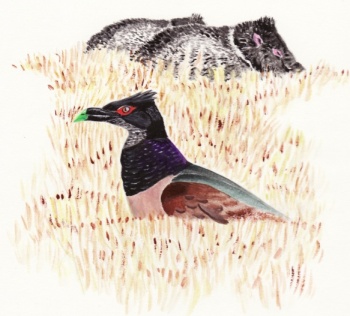(→Taxonomy: Update link) |
|||
| (6 intermediate revisions by 5 users not shown) | |||
| Line 1: | Line 1: | ||
| − | {{ | + | [[Image:Rufous-Winged_Ground-Cuckoo.jpg|thumb|550px|right|Image by {{user|José+Merízio+Jr|José Merízio Jr}}]] |
| − | ;Neomorphus rufipennis | + | ;[[:Category:Neomorphus|Neomorphus]] rufipennis |
==Identification== | ==Identification== | ||
| + | 50cm. A large Ground Cuckoo. | ||
| + | * Dark bronzy-green upperparts | ||
| + | * Purplish-glossed black crest | ||
| + | * Purplish-black head, neck and chest | ||
| + | * Red eye with red bare skin around it | ||
| + | * Ashy-white to grey throat (sometimes black) | ||
| + | * Dull grey-brown underparts | ||
| + | * Purplish-red wings with dark brown primaries | ||
| + | * Black bill with greenish tip | ||
| + | Females similar but with brown eyes. No information on juvenile plumage. | ||
| + | [[Image:Rufous-winged_Ground_Cuckoo_fem.jpg|thumb|350px|right|Image by {{user|bru.b|bru.b}} - Female]] | ||
==Distribution== | ==Distribution== | ||
| + | Found in southern [[Venezuela]], [[Guyana]] and in northern [[Brazil]] (Roraima, near upper R Branco).<br /> | ||
| + | A rare and poorly known species. | ||
==Taxonomy== | ==Taxonomy== | ||
| + | This is a [[Dictionary_M-O#M|monotypic]] species. | ||
| + | |||
==Habitat== | ==Habitat== | ||
| + | Moist lowland forests.<br /> | ||
| + | Occurs in lowlands and foothills up to 1100m, probably higher. | ||
| + | Tropical lowland evergreen forests, high-ground forest, also transitional forest with seasonal inundations, in Ficus and Heliconia, canebrakes and thickets. Lowlands and foothills to 1200 m, to 1650 m in Bolivia. | ||
==Behaviour== | ==Behaviour== | ||
| − | == | + | A solitary and shy species. Wary and restless. Runs fast on the ground, sometimes seen perched in middle branches of trees. Often seen close to peccaries. |
| + | ====Diet==== | ||
| + | Not recorded. Probably large insects, small vertebrates and seeds and fruit like other Ground Cuckoos from South America. | ||
| + | ====Breeding==== | ||
| + | No information on nest. The eggs are yellowish white. | ||
| + | ====Movements==== | ||
| + | A resident species. | ||
| + | ==References== | ||
| + | #{{Ref-Clements6thAug13}}#{{Ref-HBWVol4}} | ||
| + | {{ref}} | ||
==External Links== | ==External Links== | ||
{{GSearch|Neomorphus+rufipennis}} | {{GSearch|Neomorphus+rufipennis}} | ||
| − | [[Category:Birds]] [[Category:Missing Images]] | + | [[Category:Birds]] [[Category:Neomorphus]][[Category:Missing Images]][[Category:Artwork Only]] |
Latest revision as of 18:49, 7 July 2014

- Neomorphus rufipennis
Identification
50cm. A large Ground Cuckoo.
- Dark bronzy-green upperparts
- Purplish-glossed black crest
- Purplish-black head, neck and chest
- Red eye with red bare skin around it
- Ashy-white to grey throat (sometimes black)
- Dull grey-brown underparts
- Purplish-red wings with dark brown primaries
- Black bill with greenish tip
Females similar but with brown eyes. No information on juvenile plumage.

Distribution
Found in southern Venezuela, Guyana and in northern Brazil (Roraima, near upper R Branco).
A rare and poorly known species.
Taxonomy
This is a monotypic species.
Habitat
Moist lowland forests.
Occurs in lowlands and foothills up to 1100m, probably higher.
Tropical lowland evergreen forests, high-ground forest, also transitional forest with seasonal inundations, in Ficus and Heliconia, canebrakes and thickets. Lowlands and foothills to 1200 m, to 1650 m in Bolivia.
Behaviour
A solitary and shy species. Wary and restless. Runs fast on the ground, sometimes seen perched in middle branches of trees. Often seen close to peccaries.
Diet
Not recorded. Probably large insects, small vertebrates and seeds and fruit like other Ground Cuckoos from South America.
Breeding
No information on nest. The eggs are yellowish white.
Movements
A resident species.
References
- Clements, J. F., T. S. Schulenberg, M. J. Iliff, B.L. Sullivan, C. L. Wood, and D. Roberson. 2013. The eBird/Clements checklist of birds of the world: Version 6.8., with updates to August 2013. Downloaded from http://www.birds.cornell.edu/clementschecklist/download/
- Del Hoyo, J, A Elliot, and J Sargatal, eds. 1997. Handbook of the Birds of the World. Volume 4: Sandgrouse to Cuckoos. Barcelona: Lynx Edicions. ISBN 978-8487334221
Recommended Citation
- BirdForum Opus contributors. (2024) Rufous-winged Ground Cuckoo. In: BirdForum, the forum for wild birds and birding. Retrieved 27 April 2024 from https://www.birdforum.net/opus/Rufous-winged_Ground_Cuckoo



